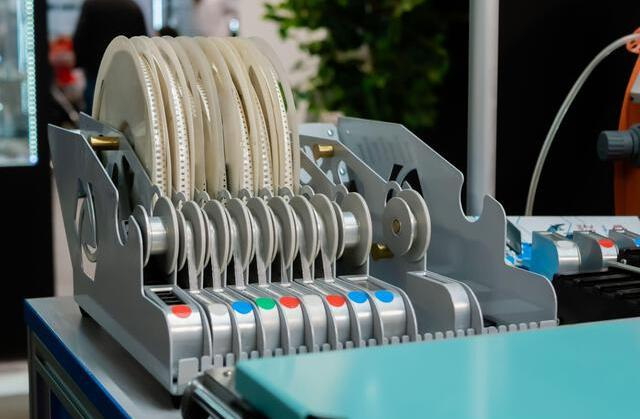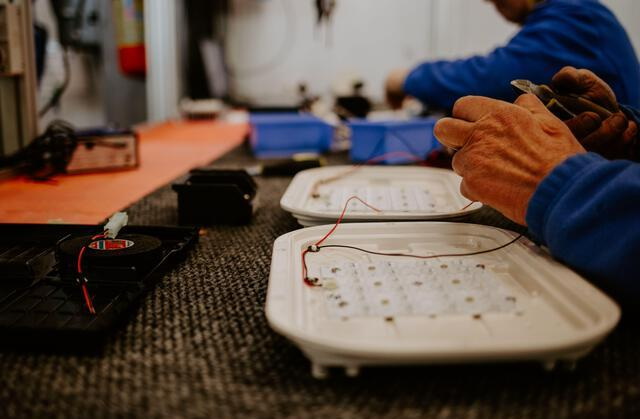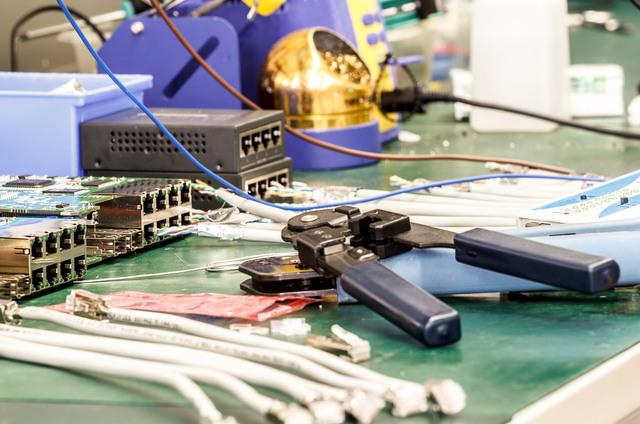Content Menu
● Understanding SMT Stencil Laser Cutting
>> Key Features of SMT Stencil Laser Cutting
● The Importance of Precision in SMT Stencils
● Steps to Achieve Precision Cuts with an SMT Stencil Laser Cutter
>> 1. Stencil Design Preparation
>> 2. Material Selection
>> 3. Laser Cutter Setup
>> 4. Cutting Process
>> 5. Post-Cutting Treatment
● Advanced Technologies Enhancing SMT Stencil Laser Cutting
>> Adaptive Laser Control
>> Vision Systems and Alignment
>> Multi-Layer Stencil Cutting
● Benefits of Using an SMT Stencil Laser Cutter
● Best Practices for Maximizing Precision with SMT Stencil Laser Cutters
● Common Challenges and Solutions in SMT Stencil Laser Cutting
>> Thermal Distortion
>> Burr Formation
>> Aperture Size Variability
● Future Trends in SMT Stencil Laser Cutting
● Conclusion
● FAQ
>> 1. What is an SMT stencil laser cutter?
>> 2. How precise can laser cutting be for SMT stencils?
>> 3. What materials are used for SMT stencils?
>> 4. How does laser cutting compare to chemical etching for SMT stencils?
>> 5. What are common challenges in laser cutting SMT stencils and how to overcome them?
● Citations:
Surface Mount Technology (SMT) stencils are critical components in the electronics manufacturing process, enabling the precise application of solder paste onto printed circuit boards (PCBs). The quality and accuracy of these stencils directly influence the reliability and performance of electronic assemblies. Among various manufacturing methods, laser cutting has emerged as the leading technology for producing high-precision SMT stencils. This article explores how to achieve precision cuts with an SMT stencil laser cutter, detailing the technology, best practices, and benefits.

Understanding SMT Stencil Laser Cutting
An SMT stencil is typically a thin metal sheet, often stainless steel, with apertures laser cut to match the footprint of surface mount devices on a PCB. The laser cutting process uses a focused beam of light to vaporize material and create apertures with exceptional accuracy and clean edges.
Key Features of SMT Stencil Laser Cutting
- High Precision: Laser cutting can achieve positional accuracy and hole shape precision within ±5 microns, far surpassing traditional chemical etching methods which have tolerances around ±50 microns.
- Smooth Edges: The laser produces burr-free, smooth cutting surfaces that improve solder paste release and printing quality.
- Fine Apertures: Laser cutters can create extremely small apertures, with openings as small as 18 microns on thin stencil sheets, suitable for fine-pitch components and microelectronics.
- Material Versatility: Typically, stainless steel sheets ranging from 0.05mm to 0.40mm thickness are used, allowing for customizable stencil thickness based on PCB requirements.
- High-Speed Production: Advanced laser systems can cut up to 20,000 apertures per hour, enabling rapid prototyping and high-volume manufacturing.
The Importance of Precision in SMT Stencils
Precision in SMT stencil apertures is vital because the stencil controls the amount and location of solder paste deposited on the PCB pads. Any deviation in aperture size or placement can cause:
- Solder Bridging: Excess solder paste can create shorts between adjacent pins.
- Insufficient Solder: Undersized apertures can lead to weak joints and component failures.
- Misalignment: Improper aperture positioning results in poor solder paste registration, causing defects during assembly.
Therefore, achieving precision cuts with an SMT stencil laser cutter directly impacts the yield, reliability, and performance of electronic devices.
Steps to Achieve Precision Cuts with an SMT Stencil Laser Cutter
1. Stencil Design Preparation
Before laser cutting, a precise digital design of the stencil apertures must be prepared. This involves:
- Creating CAD files that map the exact locations and shapes of the apertures corresponding to the PCB layout.
- Ensuring aperture shapes are optimized for solder paste release, often with cone-shaped openings to facilitate clean printing.
- Selecting appropriate stencil thickness and material based on the PCB and component specifications.
Design software often includes features to simulate solder paste deposition, helping engineers optimize aperture shapes and sizes to reduce defects.
2. Material Selection
Choosing the right stencil material is crucial:
- Stainless Steel is the most common due to its durability, heat resistance, and compatibility with laser cutting.
- Thickness typically ranges from 0.05mm to 0.40mm, with thinner sheets used for fine-pitch components.
- Some applications may use nickel or other alloys, but stainless steel remains the industry standard.
Material quality affects not only cutting precision but also stencil longevity and resistance to wear during repeated printing cycles.
3. Laser Cutter Setup
Proper setup of the laser cutter ensures precision:
- Laser Power and Speed: Adjust laser power and cutting speed to avoid melting or deformation. Excessive power can cause burrs or enlarged apertures, while insufficient power may leave uncut areas.
- Focus and Alignment: Use autofocus systems and laser-based frame alignment to maintain consistent focal distance and exact positioning of the stencil sheet.
- Thermal Management: Employ cooling techniques such as placing wet paper or heat-absorbing layers around the stencil to prevent heat buildup and material melting during cutting.
Modern SMT stencil laser cutters often feature closed-loop feedback systems that monitor cutting quality in real time, adjusting parameters dynamically to maintain precision.
4. Cutting Process
- Use advanced laser systems capable of high-frequency pulsing to minimize heat-affected zones.
- Employ half-cut optical identification points or repositioning functions to ensure holes are cut precisely without distortion.
- Maintain a clean cutting environment to prevent contamination and ensure smooth cuts.
- The laser beam diameter is typically between 10 to 20 microns, enabling the creation of extremely fine apertures.
5. Post-Cutting Treatment
- Polishing: Some manufacturers apply special polishing to the stencil surface to enhance smoothness and solder paste release.
- Inspection: Use optical inspection tools to verify aperture dimensions and positional accuracy, ensuring tolerances are met.
- Cleaning: Remove any debris or residues to maintain stencil quality and prolong lifespan.
Post-processing can also include electro-polishing, which further smooths aperture edges and improves solder paste release characteristics.

Advanced Technologies Enhancing SMT Stencil Laser Cutting
Adaptive Laser Control
Adaptive laser control technologies monitor the cutting process in real-time, adjusting laser power and speed based on material response. This ensures consistent aperture quality across different stencil thicknesses and materials.
Vision Systems and Alignment
Integrated vision systems enable automatic recognition of fiducial marks on the stencil sheet, ensuring that the laser cutter aligns perfectly with the design file. This reduces positional errors and improves repeatability.
Multi-Layer Stencil Cutting
Some advanced SMT stencil laser cutters are capable of cutting multi-layer stencils, which combine different thicknesses or materials to optimize solder paste deposition for complex PCB assemblies.
Benefits of Using an SMT Stencil Laser Cutter
- Unmatched Precision: Achieve aperture tolerances as tight as ±5 microns, essential for fine-pitch and high-density PCB assemblies.
- Consistent Quality: Laser cutting provides uniform aperture shapes and sizes, improving solder paste deposition consistency and reducing defects.
- Faster Turnaround: High-speed laser cutting accelerates stencil production, supporting rapid prototyping and flexible manufacturing.
- Environmental Friendliness: Unlike chemical etching, laser cutting avoids harsh chemicals, minimizing environmental impact and waste.
- Design Flexibility: Laser cutters can produce complex stencil geometries and quick design changes without retooling.
- Reduced Waste: Laser cutting is a non-contact process that minimizes material waste and eliminates the need for chemical disposal.
Best Practices for Maximizing Precision with SMT Stencil Laser Cutters
- Regular Calibration: Keep the laser cutter well-calibrated to maintain cutting accuracy over time.
- Use High-Quality Materials: Consistent material quality reduces variability in cutting results.
- Optimize Laser Parameters: Fine-tune laser power, speed, and focus for each stencil thickness and material.
- Implement Thermal Controls: Use cooling methods during cutting to prevent thermal distortion.
- Routine Maintenance: Clean optics and mechanical parts to ensure consistent laser performance.
- Training Operators: Skilled operators who understand laser cutting nuances can better manage machine settings and troubleshoot issues.
- Quality Control: Employ automated optical inspection (AOI) systems post-cutting to verify stencil quality before shipment.
Common Challenges and Solutions in SMT Stencil Laser Cutting
Thermal Distortion
Excessive heat from the laser can warp the stencil or cause aperture edges to melt. To mitigate this:
- Use pulsed laser modes to reduce continuous heat input.
- Apply cooling layers such as wet paper or heat sinks beneath the stencil.
- Optimize laser power and cutting speed to balance cutting efficiency and heat generation.
Burr Formation
Burrs can affect solder paste release and printing quality. Solutions include:
- Using ultra-short pulse lasers (femtosecond or picosecond lasers) to minimize thermal effects.
- Post-cutting polishing or electro-polishing to smooth aperture edges.
Aperture Size Variability
Variations in aperture size can cause inconsistent solder paste volume. To control this:
- Maintain strict laser parameter control and calibration.
- Use real-time monitoring systems to detect deviations and adjust cutting parameters dynamically.
Future Trends in SMT Stencil Laser Cutting
- Ultra-Short Pulse Lasers: Emerging femtosecond laser technology promises even higher precision with minimal thermal damage.
- AI-Driven Process Optimization: Artificial intelligence algorithms will analyze cutting data to optimize parameters automatically.
- Integration with PCB Design Software: Direct import of PCB layout files into laser cutters will streamline stencil production workflows.
- Eco-Friendly Manufacturing: Continued reduction in energy consumption and waste generation will make laser cutting even more sustainable.
Conclusion
Achieving precision cuts with an SMT stencil laser cutter is a combination of advanced laser technology, meticulous design, and optimized process control. Laser cutting offers superior accuracy, speed, and environmental benefits compared to traditional methods, making it the preferred choice for modern electronics manufacturing. By following best practices in design, material selection, laser setup, and post-processing, manufacturers can produce high-quality SMT stencils that enhance solder paste application, improve assembly yields, and support the demands of increasingly complex PCB designs. As laser cutting technology continues to evolve, the precision and efficiency of SMT stencil manufacturing will only improve, driving innovations in electronics assembly and production.

FAQ
1. What is an SMT stencil laser cutter?
An SMT stencil laser cutter is a machine that uses a focused laser beam to cut precise apertures in thin metal sheets, typically stainless steel, to create stencils used for applying solder paste on PCBs.
2. How precise can laser cutting be for SMT stencils?
Laser cutting can achieve precision within ±5 microns for aperture position and shape, enabling the production of very fine and complex stencil patterns.
3. What materials are used for SMT stencils?
The most common material is stainless steel due to its durability and heat resistance. Thickness ranges from 0.05mm to 0.40mm depending on application requirements.
4. How does laser cutting compare to chemical etching for SMT stencils?
Laser cutting offers higher precision, cleaner edges, faster production, less environmental impact, and better aperture consistency compared to chemical etching.
5. What are common challenges in laser cutting SMT stencils and how to overcome them?
Challenges include thermal distortion and melting of stencil material. These can be mitigated by optimizing laser power and speed, using thermal management techniques like wet paper layers, and ensuring proper focus and alignment.
Citations:
1.https://smartsmttools.com/product-item/laser-cut-smt-stencils-2/
2.https://www.lpkfusa.com/products-and-technologies/pcb-production-lasers/smt-stencil-cutting
3.https://www.lpkf.com/en/industries-technologies/electronics-manufacturing/smt-stencils-and-micro-cut-parts
4.https://www.stencilsunlimited.com/t/smt-stencils/laser-cut-smt-stencils
5.https://blueringstencils.com/laser-cut-solder-stencil/
6.https://www.gssmt-parts.com/what-are-the-benefits-of-using-laser-cut-smt-stencils.html
7.https://www.lioncircuits.com/faq/pcb-assembly/what-is-a-smt-stencil-and-why-is-it-needed-for-assembly
8.https://www.youtube.com/watch?v=Toaz0Hi3miY
9.https://www.youtube.com/watch?v=WfyZK2GO3Sc
10.https://www.istglobe.com/news/8-faqs-of-smt-stencil-68398911.html
11.https://www.youtube.com/watch?v=WlvlHMxde3A
12.https://www.stentech.com/company/faq




















